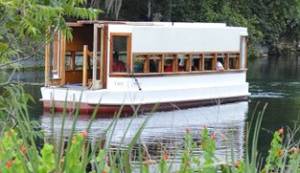Restored glass-bottom boat takes maiden voyage back to Spring Lake

Posted by Jayme Blaschke
Office of Media Relations
May 24, 2016
The Meadows Center for Water and the Environment at Texas State University welcomed back Boat 1953, the first of five newly renovated glass-bottom boats, to Spring Lake on May 20.
In 2014, craftsman Nick Chappell of Wimberley began the process of redesigning and replacing the wooden-framed hulls with a fiberglass composite hull. Then, Cougar Marine USA was subcontracted to build a mold that would frame the new composite hull.
“A 100 percent composite and fiberglass boat only made sense, as it is not subject to wood rot, waterlogging, and the exterior finish is basically perfect as it is molded,” said Bill Gagan, general manager of Cougar Marine, who signed on to conduct the overhauls. “Now they will have little or no repairs, just cleaning to do.”
In 1946, Paul Rogers led the first tour of Spring Lake on a homemade glass-bottom rowboat and generations have since explored the sacred headwaters of the San Marcos River on glass-bottom boats. Today, they are the centerpiece of The Meadows Center’s environmental education program.
“All of these [boats] were hand built by many different individuals, so none of them are exactly the same,” Spring Lake Manager Aaron Wallendorf said.
The nature of the glass-bottom boat’s wooden hulls presented a demanding maintenance schedule for The Meadows Center, with issues ranging from dry rot by fungus, corrosion from fasteners, or less than perfect lumber.
“Roughly 80 percent of the yearly glass-bottom boat maintenance and restoration cost is related to the wooden framed hulls,” Spring Lake Educational Operations Manager Deborah Lane said.
Restoration on a unique item like the boats typically required a craftsman with an array of knowledge and skills; everything is custom.
“Fortunately, we found that craftsman in Nick Chappell, who was awarded the contract by Texas State University to refurbish the five remaining glass-bottom boats,” Lane said.
Gagan, a veteran of both the fiberglass and boat industry, had been involved in the composites industry for around 45 years. “I've probably designed, built and fabricated more tooling and molds than anyone alive, around 20,000 or so.”
Due to the size and unique nature of the glass-bottom boats, the work was quite an undertaking. In order to make a mold to form the new hull, a representation of the finished product—a plug—had to be made. Making a plug was a difficult job due its shape and slim sides, but the biggest obstacle of the entire project was yet to come.
“Even worse was the challenge of how to spray the gel coat into that deep canyon [of the mold] and install many layers of fiberglass without cosmetic defects, air pockets, and voids,” Gagan said. “That's when we decided to make a six-part mold, not a one-part mold.”
Each part could be unbolted from the others in order to spray on the gel coat, after which they were reassembled for the fiberglass to be laid in. While a time-consuming, expensive process, the end result was a perfect one-piece hull.
The time from start to finish took Cougar Marine approximately 10 months. The good news: now that they have the molds, the next four boats should take less time and money to build.
“This was a very challenging project, but also a lot of fun,” Gagan said. “Before we take on another one of this complexity, we need a year or so to recover!”
With a full schedule of field trip and public tours, Boat 1953 is adapting well to its life back on Spring Lake.
“Glass-bottom boat 1953 was designed to look more like the original boats with a canopy top, rather than the hard top later used on all the boats. Lighter in weight and more open, it drives like a Ferrari,” Lane said. “Everyone lines up in front of the gate wanting to take a tour on the new ’53!”
About The Meadows Center for Water and the Environment
The Meadows Center for Water and the Environment was named following a generous gift from The Meadows Foundation in August 2012. The Meadows Center for Water and the Environment is dedicated to environmental research, stewardship, education and service. It is run by renowned conservationist Andrew Sansom.